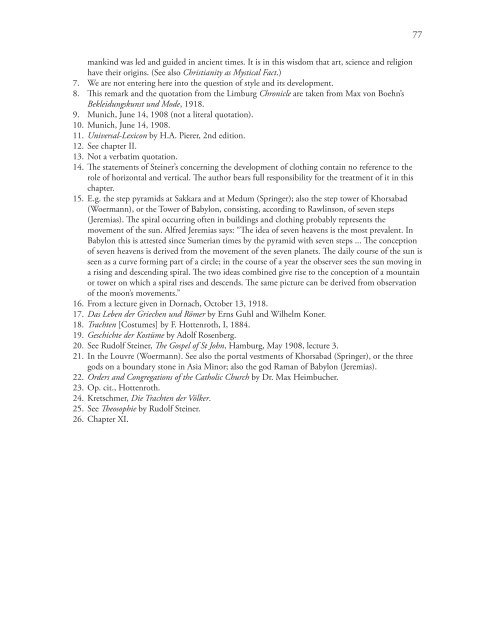Handwork and Handicrafts - Waldorf Research Institute
Handwork and Handicrafts - Waldorf Research Institute
Handwork and Handicrafts - Waldorf Research Institute
Create successful ePaper yourself
Turn your PDF publications into a flip-book with our unique Google optimized e-Paper software.
mankind was led <strong>and</strong> guided in ancient times. It is in this wisdom that art, science <strong>and</strong> religion<br />
have their origins. (See also Christianity as Mystical Fact.)<br />
7. We are not entering here into the question of style <strong>and</strong> its development.<br />
8. This remark <strong>and</strong> the quotation from the Limburg Chronicle are taken from Max von Boehn’s<br />
Bekleidungskunst und Mode, 1918.<br />
9. Munich, June 14, 1908 (not a literal quotation).<br />
10. Munich, June 14, 1908.<br />
11. Universal-Lexicon by H.A. Pierer, 2nd edition.<br />
12. See chapter II.<br />
13. Not a verbatim quotation.<br />
14. The statements of Steiner’s concerning the development of clothing contain no reference to the<br />
role of horizontal <strong>and</strong> vertical. The author bears full responsibility for the treatment of it in this<br />
chapter.<br />
15. E.g. the step pyramids at Sakkara <strong>and</strong> at Medum (Springer); also the step tower of Khorsabad<br />
(Woermann), or the Tower of Babylon, consisting, according to Rawlinson, of seven steps<br />
(Jeremias). The spiral occurring often in buildings <strong>and</strong> clothing probably represents the<br />
movement of the sun. Alfred Jeremias says: “The idea of seven heavens is the most prevalent. In<br />
Babylon this is attested since Sumerian times by the pyramid with seven steps ... The conception<br />
of seven heavens is derived from the movement of the seven planets. The daily course of the sun is<br />
seen as a curve forming part of a circle; in the course of a year the observer sees the sun moving in<br />
a rising <strong>and</strong> descending spiral. The two ideas combined give rise to the conception of a mountain<br />
or tower on which a spiral rises <strong>and</strong> descends. The same picture can be derived from observation<br />
of the moon’s movements.”<br />
16. From a lecture given in Dornach, October 13, 1918.<br />
17. Das Leben der Griechen und Römer by Erns Guhl <strong>and</strong> Wilhelm Koner.<br />
18. Trachten [Costumes] by F. Hottenroth, I, 1884.<br />
19. Geschichte der Kostüme by Adolf Rosenberg.<br />
20. See Rudolf Steiner, The Gospel of St John, Hamburg, May 1908, lecture 3.<br />
21. In the Louvre (Woermann). See also the portal vestments of Khorsabad (Springer), or the three<br />
gods on a boundary stone in Asia Minor; also the god Raman of Babylon (Jeremias).<br />
22. Orders <strong>and</strong> Congregations of the Catholic Church by Dr. Max Heimbucher.<br />
23. Op. cit., Hottenroth.<br />
24. Kretschmer, Die Trachten der Völker.<br />
25. See Theosophie by Rudolf Steiner.<br />
26. Chapter XI.<br />
77

















